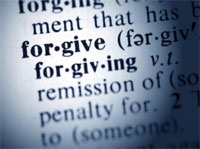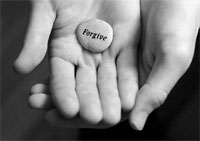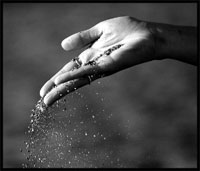The one of "Letting Go" : The Art of Forgiveness
Overview
"The weak can never forgive. To let go of things is the attribute of the strong."
-- Mahatma Gandhi
Keeping grudges is like pushing a cart full of emotions in a shopping spree that will only empty your pocket without giving any satisfaction. Not letting go of someone's mistakes and rude behavior is making that life inside you rent-free.
Also, the more baggage we collect for the grudges we keep, the more acquiescing our attitude becomes towards vengeance for them and we lose out focus on many important and time-worthy things of our lives.
How to become a more forgiving person and broaden your forgiving character? You can truly become a person who has few unresolved hurts and can quickly and thoroughly resolve new hurts.
We will follow 6 lessons that revolve around using a 5-step model of forgiveness to address a hurt or offense you have experienced in your lifetime. For more information about the power of forgiveness and the model used in this course, feel free to watch the following video:
When to Seek Professional Help
If you continue to experience difficulties with unresolved hurts after completing this course, consider seeking professional help. We can assist you in locating a therapist that is geographically close to you.
Forgiving in Context
Goal
To identify a hurt in need of forgiveness and to further your knowledge about forgiveness
Identify Your Hurt
To become a more forgiving person, first, identify a hurt or offense. It is best to initially choose an issue that is of moderate importance to you. If the harm you select is too traumatic and emotionally raw, you might be so distressed that it impedes your ability to effectively implement the five-step model presented in this course.
On the other hand, if the harm has already been put far in your past and no longer bothers you, you probably won’t be experiencing enough emotional pain to benefit from this model. Once you have learned the 5 steps, you can apply them to a variety of hurts.
Identify Your Hurt Exercise (Worthington, 2011, pp. 7-8)
Instructions: Answer these questions to identify and better understand your hurt:
- Describe the event.
- Write briefly how you felt and reacted to the event in the days following it.
- Write briefly about things related to the event that has happened since it occurred that have affected your current feelings and motivations.
Types of Forgiveness (Worthington, 2011, pp. 20, 22)
Worthington (2001) suggests that forgiveness is tied to making a decision to forgive those who harm us. That decision binds us to treat the person who hurt us as a person of value rather than acting negatively toward the person. It also suggests that experiencing emotional forgiveness might take longer than deciding to forgive. A person might sincerely decide to forgive-holding perfectly to his or her resolve not to harm the offender-but at the same time might not fully experience emotional forgiveness.
It is believed that decisional and emotional forgiveness, while sometimes occurring together, are two different processes that can occur at different times. In fact, some people can experience one and never experience the other.
An additional type of forgiveness is social/societal forgiveness. Society has social rules that help bind it together. Worthington (2001) describes the murder of his mother. Although he forgave the murderers, he still suggests that if they were to be apprehended, they would need to be imprisoned so that such a crime could not happen to other elderly women.
Deciding to Forgive Exercise
Instructions (part 1): Evaluate how strongly you desire to forgive and learn to stick by your decision.
Instructions (part 3): Ask yourself why your ratings aren’t lower than they are and what it would take to make your ratings higher.
Tip: If your ratings are low, be encouraged! You’re in the right place. Keep reading and you’ll likely become more desirous for change in this area.
Literary Quotes (Worthington, 2011, pp. 16-17)
Here are some quotes that will help to expand your understanding of forgiveness:
History, despite its wrenching pain, cannot be unlived, but if faced with courage need not be lived again.
- Maya Angelou
Hatred is the rabid dog that turns on its owner. Revenge is the raging fire that consumes the arsonist. Bitterness is the trap that snares the hunter.
- Max Lucado
Resentment is like taking poison and waiting for the other person to die.
- Malachy McCourt
We make believe we are at peace while the furies rage within, beneath the surface. There, hidden and suppressed, our hate opens the subterranean faucets of venom that will eventually infect all our relationships in ways we cannot predict. Hate left to itself, denied and hidden, leaves us in a cold hell behind insulated masks of warm conviviality.
- Lewis B. Smedes
We must develop and maintain the capacity to forgive. He who is devoid of the power to forgive is devoid of the power to love. There is some good in the worst of us and some evil in the best of us. When we discover this, we are less prone to hate our enemies.
- Martin Luther King, Jr.
Anyone who wants to forgive must come down from his [or her] throne. Otherwise, the attempt at forgiveness degenerates into an indictment, and then we should not be surprised when the other person rejects the offer.
- Peter van Breeman
Literary Quotes Exercise (Worthington, 2011, p. 18)
Instructions: Refer to the above quotes in answering these questions:
- What are your reactions to the quotes?
- Write a phrase that captures your feelings about the quotes.
- Who is doing the forgiving in each of the quotes?
- Is there anything different when forgiveness goes both ways versus when it only goes one way?
- How do the quotes relate to each other? What is a common theme among them? What is different between them?
Video Exercise (Worthington, 2011, p. 18)
Here’s a video of a famous example of forgiveness from Les Miserables. Watch the following video and answer the questions.
- Why did the bishop forgive Valjean?
- What, if anything, did the bishop have to gain by forgiving?
- How do you think Valjean felt upon this act of forgiveness?
Next Step (Worthington, 2011, p. 19)
Describe a classic story of forgiveness, maybe from a children’s story, religious passage, or movie plot. Explain why the offender committed the transgression and why the victim chose to forgive the offender. How did the act of forgiveness benefit their situation?
What is Forgiveness?
Goal
To be able to understand what forgiveness is and the reasons to forgive
What is Forgiveness? (Worthington, 2011, p. 32)

Defining Forgiveness Exercise (Worthington, 2011, p. 27)
Instructions: Read the following possible definitions of forgiveness. Two of them are accurate, some of them are not quite right, and some of them are just plain wrong. Identify which two are accurate and what the others are if they are not forgiveness.
| Possible Definitions of Forgiveness | Accurate? |
|---|---|
| 1. Telling yourself that what happened wasn’t really that bad and that you ought to just forget what happened and move on | |
| 2. Forgetting that anything bad happened, simply pushing the event or relationship out of your memory | |
| 3. Starting up your relationship with the person who hurt you again, as if nothing happened | |
| 4. Opening yourself to be hurt again | |
| 5. Accepting an excuse or explanation for what someone did or is doing to you | |
| 6. Doing whatever you can to smooth over conflict | |
| 7. A voluntary release of your right to condemn and get revenge on the person who hurt you because you have different feelings toward the person | |
| 8. Tolerating negative things that someone has done or continues to do to you | |
| 9. Accepting people despite their flaws | |
| 10. Blaming and confronting the person who hurt you | |
| 11. Getting someone who hurt you to believe that everything is still okay | |
| 12. Getting even with the person who hurt you | |
| 13. Voluntary decision to give up the right to revenge and release a person from any interpersonal debt incurred by wronging you. | |
| 14. Having the other person apologize, express regret, or beg forgiveness until the balance of justice has been restored. |
Defining Forgiveness (Worthington, 2011, p. 28)
Here are explanations about the accuracy of the above definitions of forgiveness:
 This is denial. If you are hurt and you try to deny it to yourself, the denial seldom works. The hurt keeps resurfacing and you never seem to be free of it.
This is denial. If you are hurt and you try to deny it to yourself, the denial seldom works. The hurt keeps resurfacing and you never seem to be free of it.- Forgetting is impossible. Memory has been formed. The memory may shift with time. It may change. Or the pain you associate with the memory may even diminish or disappear. But you simply won’t be able to completely forget. The disturbing part of trying to forget is that the harder you try, the less you will succeed.
- Trying to start over might actually smooth out the relationship, but smoothing out the relationship is not forgiving. In addition, pretending that the event didn’t matter might communicate to the person who hurt you that it is okay to hurt you the same way again.
- Opening yourself to be hurt again is possible if you continue or restart your interaction with the person who hurt you. That decision is separate from a decision to forgive or not. You can forgive and restore the relationship (called reconciliation) or forgive and not restore the relationship. Additional options are to not forgive but choose to interact with the person (and risk further hurts) or not forgive and not choose to interact.
- You can accept an excuse or explanation and still not forgive the person for hurting you.
- Smoothing over conflict can be done whether or not you forgive.
- This is emotional forgiveness. It acknowledges that a wrong was done but chooses not to seek revenge and not to continue to condemn the person who hurt you. It is the experience of forgiving because you experience different feelings toward the person.
- Tolerating negative things will generally not stop the negative, and it will likely keep you angry and unforgiving.
- Accepting someone (with or without acknowledging the flaws) is not forgiving. We can accept a person and not forgive a hurtful act by the person, or we can forgive a hurtful act and still not accept the person.
- Blaming a person for hurting you certainly acknowledges the person’s guilt, but blame keeps the hurt “on the front burner.” Confronting the person, which is directly talking with the person about the hurt, might help the relationship (if the confrontation is done gently in love and the other person talks instead of attacking or defending). Confronting the person might also damage the relationship. Confronting is not forgiving.
- Getting someone who hurt you to believe everything is okay when you feel hurt is not forgiving; it is deception. The deception might be done for good motives, such as to spare feelings or prevent being fired by a boss. It’s also possible that the deception could have more complex or even evil motives (i.e. setting the person up so you can hurt him or her).
- Getting even is revenge, not forgiveness.
- This is decisional forgiveness. It involves your pledge that your behavior will not be aimed at revenge, but that you will try to behave as if the transgression never happened.
- While having the person apologize, express regret, or beg for forgiveness might make you willing to put the offense behind you and allow you to feel at peace, it is more similar to getting justice than forgiving. If the other person humbles himself or herself enough to satisfy your sense of justice, the other person will often feel resentful and as though you may have asked for too much.
Why Forgive? (Worthington, 2011, p. 31-32)

Take a moment to clasp your hands and extend your arms as far away from your body as you can. Imagine that in your hands is your burden of hurt and unforgiveness. You may not be ready to let go of this yet, so hold it for 30 more seconds. As your arms grow weary, think of all of the other things you could be doing with your hands (and with your life) if you could just let go and move on. Remember that holding this burden is hurting you, not your offender, but letting go will help you both. Even though you may not be ready to figuratively let go, open your hands and let your arms fall back to their natural position. Remember the relief you feel, and embrace it when you are ready to forgive.
Benefits of Forgiveness Exercise (Worthington, 2011, p. 26)
Instructions: List as many benefits of choosing to forgive as you can. Include benefits to your physical health, mental health, and relationships as well as any other aspect of life, such as spiritual.
| Categories | Benefits of Forgiveness |
|---|---|
| Physical Health | |
| Mental Health | |
| Relationships | |
| Other |
Assessing Your Hurt Exercise (Worthington, 2011, p. 30)
Instructions (part 1): Think about the time that someone hurt you. Try to get back into how you felt around that period of your life trying to remember vividly how you reacted to the hurt. Identify which of the following kinds of hurt you felt from the person who hurt you. Then, reflect on your feelings when you learned about the person’s hurtful actions.

Rejection: I experienced the loss of some important parts of our relationship and felt that some personal flaw of mine might have been the cause of the loss of the relationship.
Abandonment: I was left behind, physically or emotionally. This experience left me feeling fearful and insecure about the future.
Ridicule: I was the object of his/her anger and mockery. I sometimes wonder if the ridicule was deserved or accurate.
Humiliation: I lost every shred of pride and dignity I had.
Betrayal: My confidence was completely destroyed.
Deception: I was lied to, cheated on, or deceived.
Abuse: I was treated in a way that degraded who I am and robbed me of my dignity-emotionally, physically, or sexually.
Separated, unconnected, or estranged: I felt a loss of connection.
Instructions (part 2): Answer these questions about how you may be nurturing your hurt.
- Are there any ways that you are possibly nurturing the hurt in your mind now? Can you think of any ways that you think about the event(s) that happened to you that may serve to continue your pain?
- What are some of the payoffs of nurturing your hurt?
- What are some of the costs of nurturing your hurt?
Next Step (Worthington, 2011, p. 32)

Recalling the Hurt
Goal
To recall and release the hurt
Experience of Grief (Worthington, 2011, p. 41)

Introduction to REACH (Worthington, 2011, p. 35)
Hopefully, you now feel that you’ve made a sincere decision to forgive regarding this transgression. Making a decision to be more forgiving is far different than actually experiencing forgiveness in your life. Otherwise, all we would have to do is make a New Year’s resolution and not have to actually live out the love of forgiveness.
Although making a decision is necessary, it is not sufficient to really change. You need to REACH forgiveness to change. The REACH forgiveness model has 5 steps:
| R | Recall the hurt through imagination |
| E | Empathize with, sympathize with, feel compassion for, and/or love the one who hurt you |
| A | Give an altruistic gift of forgiveness |
| C | Commit to the forgiveness you experienced |
| H | Hold on to forgiveness when you doubt |
Take some deep breaths before continuing. We are about to really start working toward forgiveness. Quiet yourself, relax. Then, picture the person who hurt you. Picture the experiences you had during and before and after the hurtful incident. Remember conversations and other experiences surrounding the event.
Recall the Hurt (Worthington, 2011, p. 36)
Instructions (part 1): Write about your story. Try to create a vivid picture of the event.
Instructions (part 2): Write your story again, but this time without emphasizing the perpetrator’s badness or your own victimization or the consequences this has had. Then, reflect on the differences between the first and second versions of your story.
Tip: We aren’t going to get anywhere if we keep telling the original story repeatedly. We need another, more objective story. Visualize the experience as a 3rd party observer to get more distance between yourself and what happened.
Giving Away the Hurt Exercise (Worthington, 2011, p. 37)
Instructions (part 1): This is an exercise to allow you to give away your hurt in a symbolic way. Follow these steps:
- Stand up.
- Imagine you are holding the hurt in your hands.
- Hold your arms out and imagine that you are trying to keep the hurt contained inside your hands-trying to keep it at arm’s length from you.

Instructions (part 2): Now, if you’ve done this, imagine yourself making a decision to release the hurt. To symbolize this-regardless of whether you feel like really forgiving at this moment-open your hands and suddenly let your arms fall to your sides. You may choose to do this exercise by actually holding an object that represents the hurt.
Tip: Remember that in decisional forgiveness, you make a decision to act differently toward the person. You agree with yourself to stop holding a grudge and start trying to treat the person as a valuable person.
Instructions (part 3): Evaluate which of the following statements is true of you:
- Yes, I have decided to forgive (and I’ll try to act like it in the future)
- No, I have not yet decided to forgive; maybe later in this course
- Right now, it seems that I’ll never be able to forgive even though I want to
- Right now, I can’t see that forgiveness is going to happen
Later, after trying to change your emotions toward the person, you can come back to this. If you haven’t been able to make a decision to forgive right now, you might find it easier later.
Next Step (Worthington, 2011, pp. 39-40)
We all do things for what we believe at the time to be good reasons. Since we have all had this experience of hurting others even with the best of intentions, we can understand that the person who hurt us (in our target transgression) probably had what he or she believed to be good reasons.
Make a list of 5 times in your life thinking back to early childhood, adolescence, and more recently-that someone significantly betrayed, hurt, offended, or disappointed you. Attempt to recall each hurt objectively and empathize with the offender. Reflect on how that makes you feel.



Comments
Post a Comment